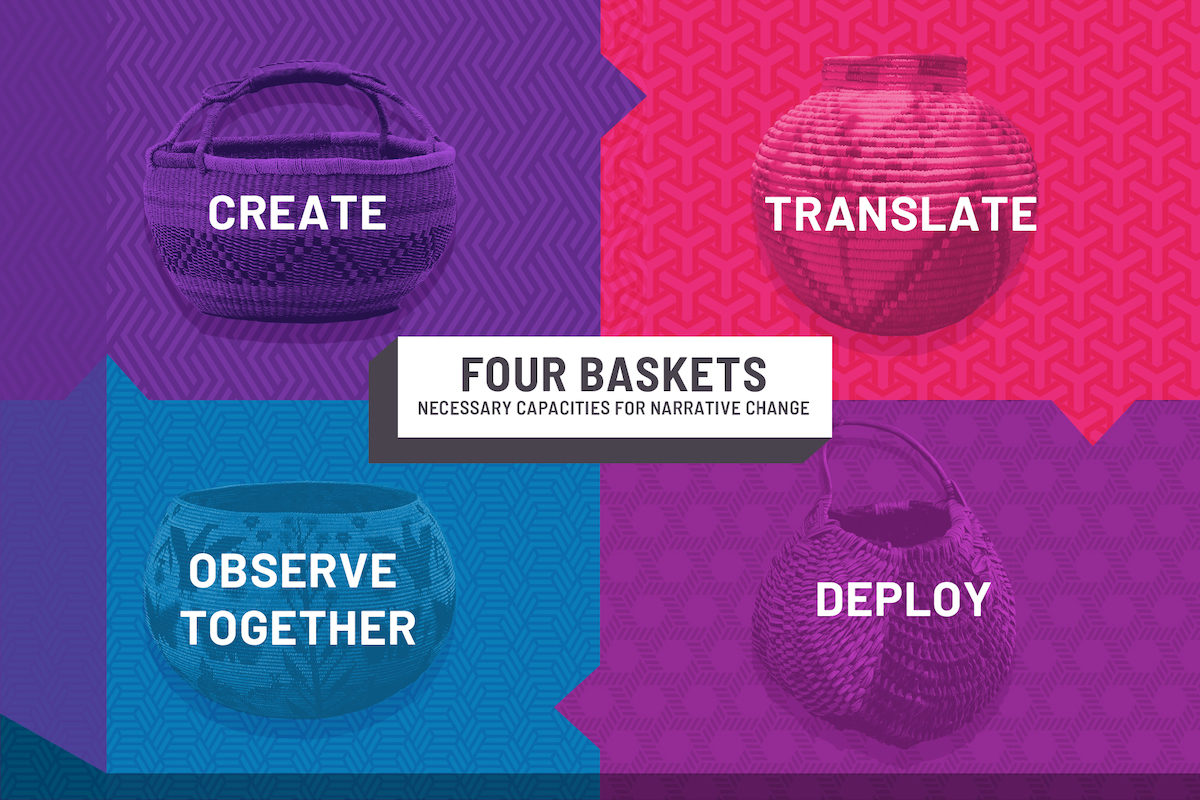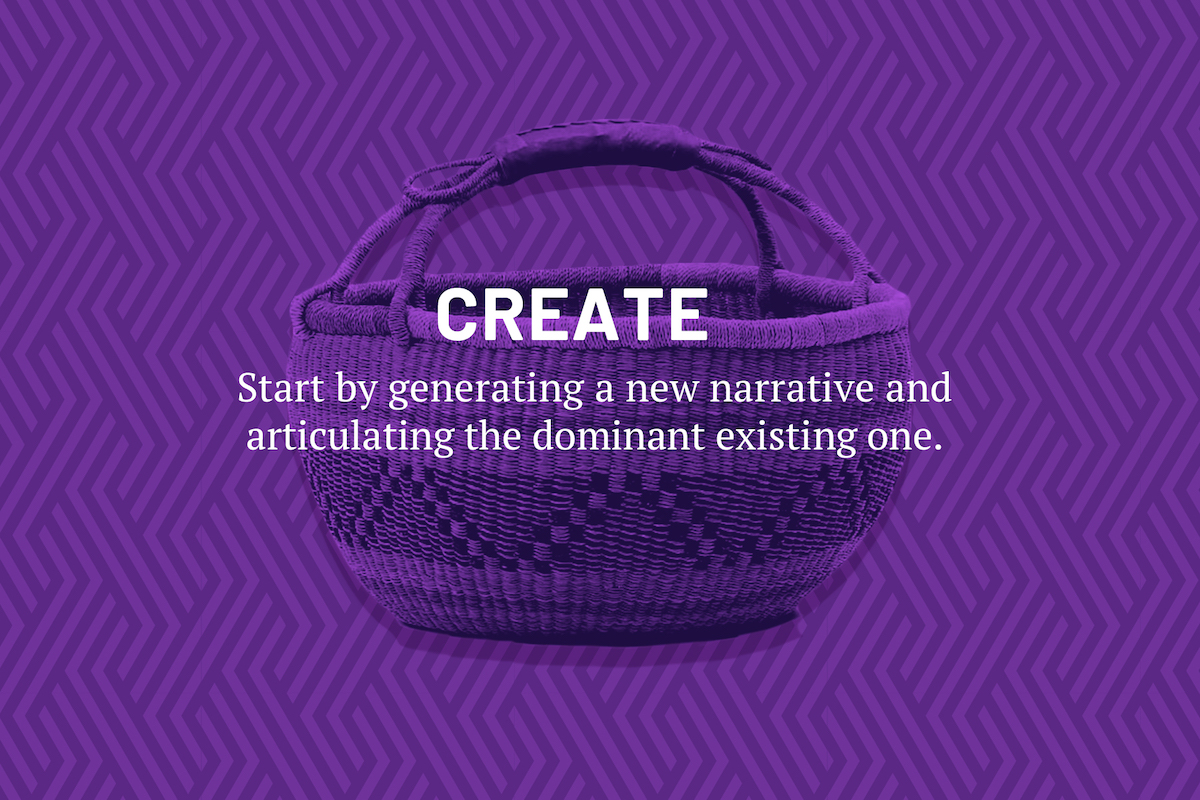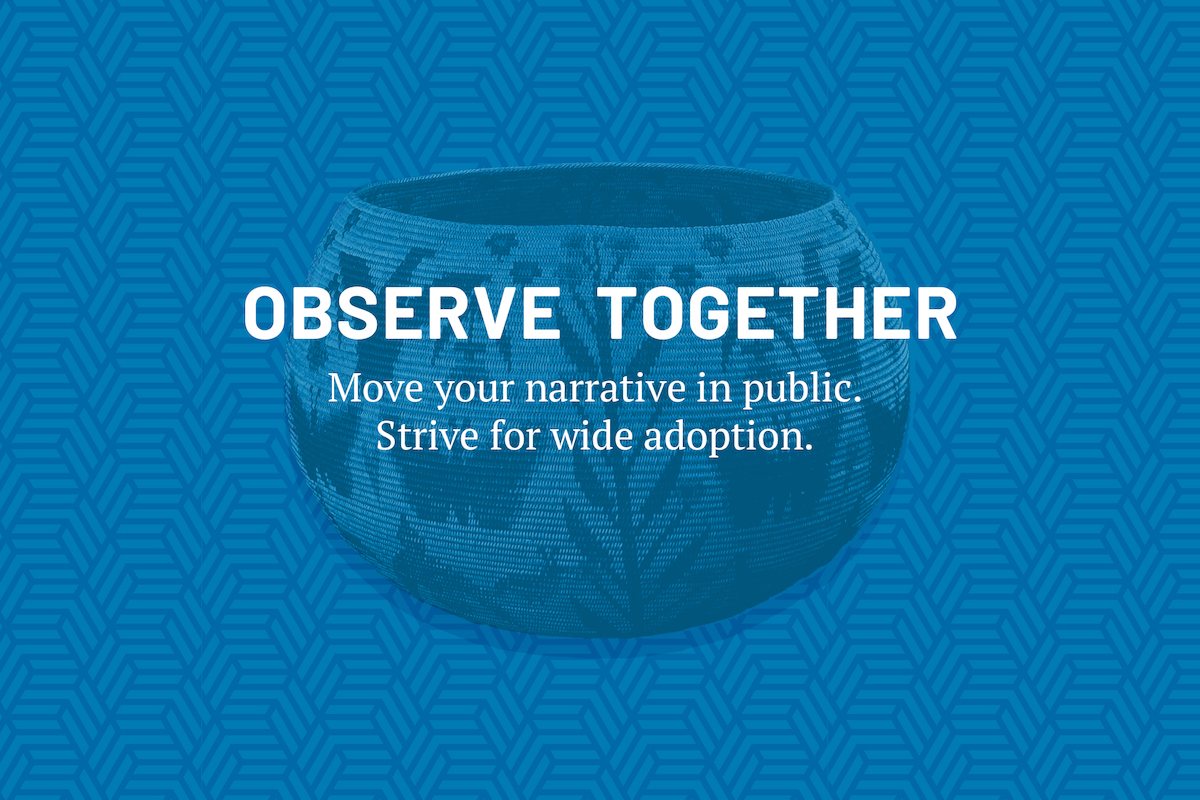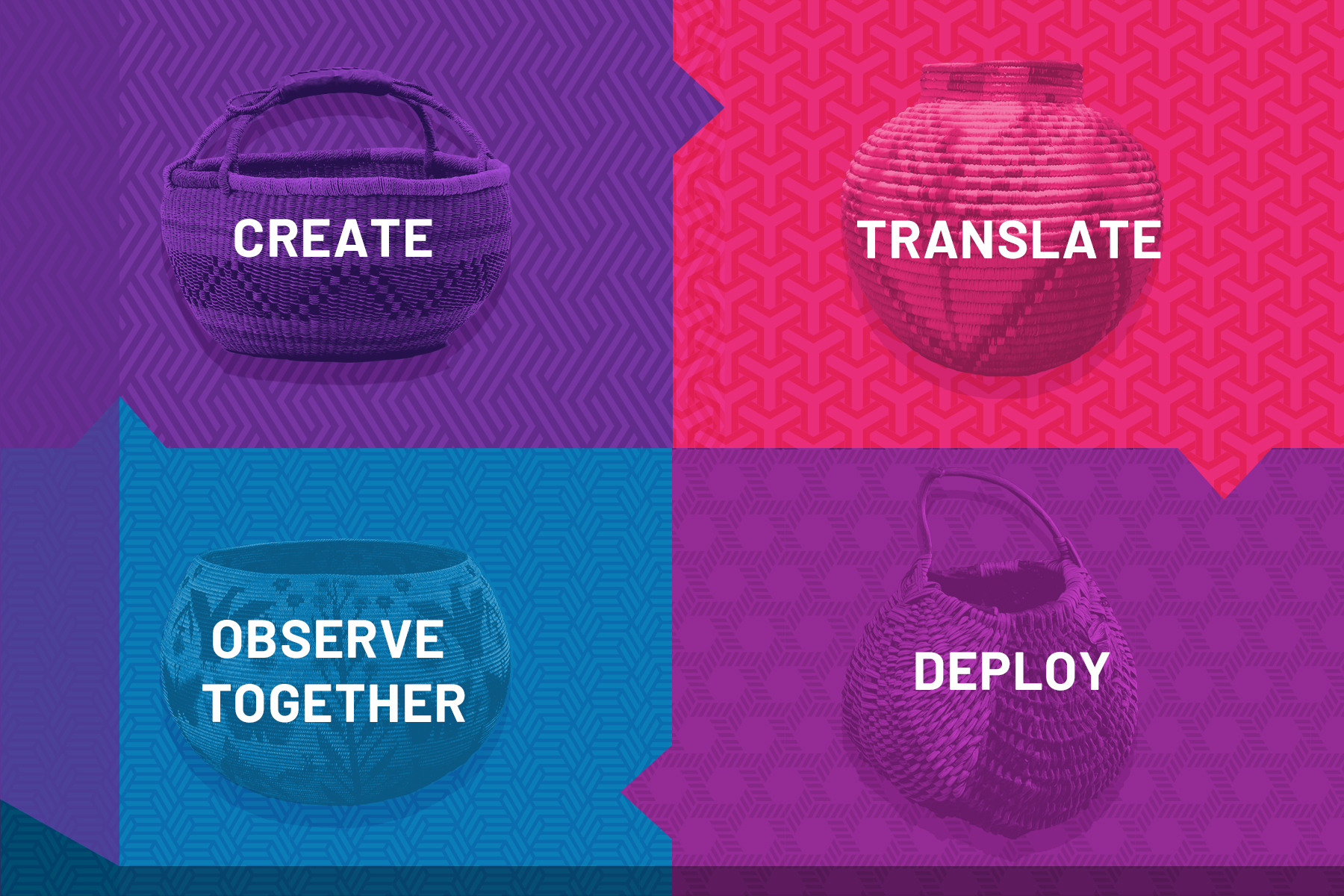Four Baskets: Necessary capacities for narrative change
The Four Baskets hold capacities and processes needed to create, implement and continually strengthen narrative change projects. As they are filled, the Four Baskets (Create, Translate, Deploy and Observe Together) provide campaigners, communicators and leaders with a framework for doing narrative change. These capacities and processes will help you identify and fill gaps, learn and iterate, and ultimately craft more durable and powerful narrative change.
Narrative change projects can be exciting to plan. They also face complex challenges that may include coalitions of diverse and possibly divergent voices, long timelines (often years and sometimes decades), and the constant headwinds of information abundance, social media and disinformation campaigns.
We have worked as narrative strategists with coalitions shifting narratives affecting economic, environmental and social policies at the state and national level. During one of these engagements, guiding Our Minnesota Future through a statewide narrative change project, we clarified and tested what we call the Four Baskets of narrative change capacity: Create, Translate, Deploy and Observe Together. We learned a ton from our experience in Minnesota and shared guides, worksheets, trainings and more here.
Narrative change projects, and the coalitions or partnerships developing and implementing them, benefit from using distinct sets of resources, skills and tools. We call these “baskets” of different capacities. The coalition in Minnesota demonstrated well developed communications skills. They also had a capacity to build and sustain alignment across divergent interests (a narrative change superpower!). But abilities to create, test and observe narrative needed to be built, shared and strengthened.
The Four Baskets maps the capacities needed to turn narrative change ideas into high-functioning narrative change projects. Filling these baskets with a rich blend of skills gives narrative projects the tools to test, iterate and ride the waves of worldview, values and storytelling.

The Four Baskets
Like real world baskets, these Four Baskets are “made to hand,” simple to pick up and ready to use. A successful narrative change project will draw upon capacities, processes and resources held in each of the Four Baskets. The narratives you create may shift and change as you move through the process. But these capacities will grow as you collaborate, learn and test.
Create
The creative act of generating a new narrative is an essential first step in narrative change practice. Early in the process, articulate both the new narrative and the existing, dominant one.
You first need to Create the deep narrative you’re shifting towards. Identifying and critiquing the current narrative is an important but insufficient act.
Narratives that endure and make an impact are, like the communities in which they seek to thrive, living things produced and cared for by many hands.
New narratives are not simply discovered. Extractive processes aren’t part of Narrative Initiative’s vision of a just and equitable future. New narratives are handmade, barn-raised and sussed out in many-voiced conversations that take time. Any healthy new narrative is likely to undergo a massively social and iterative process.
The new narrative must be catalyzed, birthed, voiced, annealed and recorded.

Understand the existing narrative landscape
Narrative creation starts with knowing where you are and where you come from. A thriving narrative contains and is shared by many voices. The tools and processes for assessing your current state are also accessible to, crafted by and shared among colleagues, friends, partners and others.
Tools and processes that define the landscape
A narrative landscape toolkit may include:
- Identifying shared values.
- Griot1-like work around preserving and embodying history.
- Archival practices.
- Media mapping and analysis to surface oppositional narratives.
- Community and movement history.
- Development of shared political analysis through political education and discussion.
- Honored presence and participation of elders in new narrative processes.
- Recognitions of trauma and the practice of trauma stewardship.
- Recognition of the relationship to the land and indigenous peoples.
- Listening processes like Narrative Landscape Analysis, Geo-specific power analysis, and Story Circle processes.
- Organizational identity formation processes. Constituencies that belong to or create organizational forms identify their own identity: who they are and what they care about. Identity fortifies a broader alliance undergoing a similar process.
Creating a new narrative
Shared understanding and language will describe who you are, where you are, and the world you want to create. Together, these components create the outline of a new narrative.
You and your coalition members may not all stay within that outline. But it offers a shared vision around which to create, translate, drive and observe narrative.
Narrative building blocks we use include futures work, art and facilitative processes. What makes narrative come alive – transition from ideas shared around a table to stories that shape behavior and shift policy – are gathering, remixing and recording. For example:
- Futures work and distillation of policy analysis into aspirational futures.
- Art that imagines the new narrative.
- Science fiction methods.
- Shared explorations of the recursive nature of wins and losses towards the goals envisioned.
- Gatherings and physical enactments of shared values.
- Facilitative processes. We use a “Narrative North Star” process at Narrative Initiative. More on this later in 2020.
Translate
In order to effectively change a narrative, it is necessary to deploy a new one in the world. Effective deployment means it is legible in many places to many audiences. Identify audiences to connect with and find ways to express the narrative.
Narrative is like a circulatory system. It moves nutrients (stories) from one part of the body to another. Stories interact but they’re always part of a narrative system. Narrative becomes the water that, with time, evolution and interpretation, may begin running through a community. Narrative is alive. The process of Translation brings narrative to life and keeps it alive.
Once a narrative is created and recorded we begin translating, mixing and re-grounding the activities of coalitions and organizations using the narrative.
Coalitions and communities need to consider how narratives translate across different constituencies and voices. A narrative that aligns across community, organizational and other boundaries will be used. Only through use can a narrative come (and be kept) alive.

Mapping translation
Start with a shared understanding of the translation landscape. Consider who will be driving the narrative. What is their worldview? How will they communicate about the narrative and with whom?
Key question: Ask yourself who is missing from this landscape. This informs your understanding of audiences as well as voices doing the translation.
Here are some tools and skills we apply to narrative translation mapping:
- Skills and resource mapping. Figure out where your comms and analytics skills are, for example. What resources and training need to be added to your coalition?
- Coalition and sector mapping.
- Narrative power analysis. Identify different narrative purveyors depending on space, position and trust.
Tools and practices for active translation
Translation is an ongoing process. We are all learning more every day about each other, our community and our narrative capacity.
Translation also means there is more than one way to talk about your narrative. The goal is to craft narratives that can travel across the waves of information, reach their destination and be accessible. A sailboat may get there. But you may need something sturdier for some audiences, experiences and identities.
- Be intentional about the process of refracting a shared narrative through the lens of different identities and experiences. A deep narrative has many strands. As you unpack the deep narrative, identify a kind of “color palette” and use different colors where appropriate. When done well, narrative change will bind these strands back together.
- Translation is a participatory process. Identify the voices that will hold your narrative. Build spaces to listen to these voices together. Learn how they interpret the narrative.
- Identify voids. Don’t limit your focus to crowded communications channels. Where are the spaces your audience isn’t receiving information? Where in the public conversation and communications spectrum is your narrative going to find room to grow?
The ultimate goal of the Translate basket is to put the narrative you’ve created to work in ways that support you specifically. Whose voices is the narrative held in, and what do they say and show? How does that narrative come to be held in the many voices of your network, coalition, community? Imagine the narrative as a light shining out through a prism, refracted visibly into its many constituent colors.
Deploy
Move your narrative in public by designing effective narrative interventions. New narratives only become dominant when they are both put into practice and adopted widely.
We have all read the news, seen a tweet go viral and watched a TV commercial. And most of us have produced, seen or read a report on campaign, email or web analytics. Driving a narrative is the act of creating a communications and marketing plan. Simple. But it’s much more, takes intention, and requires both art and skill. Fortunately, we have tools, skills and resources to drive messages in public spheres.

Tools and resources for deploying narrative
Here’s some of what we’ve found to be helpful in a narrative deployment campaign.
- Integrate rapid response and narrative practices:
- Apply new narratives to crisis moments. Do scenario planning. Be ready for opportunities you may expect (and those you don’t).
- Leverage emerging events to advance new narrative.
- Develop a set of shared images and media (art, graphs, charts, audio and video clips, fonts, etc.).
- Develop a set of discrete images and media that speak to unique organizational, coalition or individual identities.
- Organize voices that already have large audiences/megaphones. This may include influencers or celebrities. But also people who speak to niche audiences through social media, newsletters, print media and online messaging.
- Support emerging influencers.
Observe Together
Is your new narrative being adopted? Understanding the larger narrative landscape is key to being effective. Mapping before, during and after sustained efforts of narrative shift shows what is working and where to improve practice.
We use together quite intentionally here. This is the phase of narrative change strategy that includes measuring and interpreting impact, learning and understanding how to grow and sustain narrative over time.
Narrative change, as you may have inferred, happens collectively. A narrative is created, translated and deployed by coalitions, diverse voices, different interests and individuals. Each has their own experience, hopes and goals. Each will observe impact in different ways. Each will define success in individual ways.
Narrative is, ultimately, a shared project. It takes many different hands to weave a strong narrative. And it takes many hands to reach for, feel and describe the different stories that make up a narrative.
Observe Together is about measuring. But it’s not about individual success. It’s about impact but not about pageviews or shares. Campaigners and communicators come to narrative change with tool boxes full of apps, best practices and spreadsheets for evaluation and testing. We can open up these toolboxes but we shouldn’t be fixated on our hammer and nails just because we’re very good at pounding nails.

Tools and practices for evaluation
- Media maps, or other types of media landscaping research can help baseline where you’re starting from but are just a snapshot in time
- Big Listening to issues, Upwell-style, allows for ongoing monitoring against a baseline
- An old-school brand audit methodology can be iterated into a narrative audit and applied to all the partners/ campaigns in a narrative change project. What does narrative discipline look like to your effort?
- Simple visibility into all the activities of a narrative change effort can be insightful. A Tweetdeck of all the coalition partners and narrative highlights from newsletters can help illustrate collective effort.
Tools and practices for iteration and adjustment
- Design ways to stay informed and coordinated. How will your comms people and organizers know what each other is moving, narrative-wise? Shared planning processes, regular check-ins, and ways to stay aligned in a crisis are important places to Observe Together.
- How will you know when something is working? How quickly will you know? Having ways to understand this can be key to success and morale.
- Clear narrative change goals can help focus where you Observe Together.
Using the Four Baskets
Narrative is constantly alive and moving. Like a wave, the power of any particular narrative may ebb and flow. Just as narratives are moving, these baskets are meant to move with you. They’re portable!
As you add capacities to your own Four Baskets – whether through learning, adding new partners or just plain practice – you’ll find yourself moving between Baskets. You’ll create, deploy, observe and then create again. That’s good. Over time you’ll create stronger stories and narratives that challenge, even shift, values and deeply held worldviews.
Our goal with Four Baskets is to identify, strengthen and use all the muscles for narrative change work. Like any practice, the work happens over time, requires repetition, and can be challenging. But getting to the point of holding full baskets will nourish, replenish and allow you to work together with shared strength.
Here’s a handout that covers the basics of the Four Baskets. We also have a quick self-assessment worksheet you can use, with tips for how to build up capacities.
1 A griot is “is a West African historian, storyteller, praise singer, poet and/or musician. The griot is a repository of oral tradition and is often seen as a societal leader due to his or her traditional position as an advisor to royal personages.” Source: Wikipedia This explanation doesn’t quite go far enough, and other sources better describe this role as a “living archive;” and embodied, living keeper of living stories of the past. Source: Francis Bebey, African Music: A People’s Art (1975)

